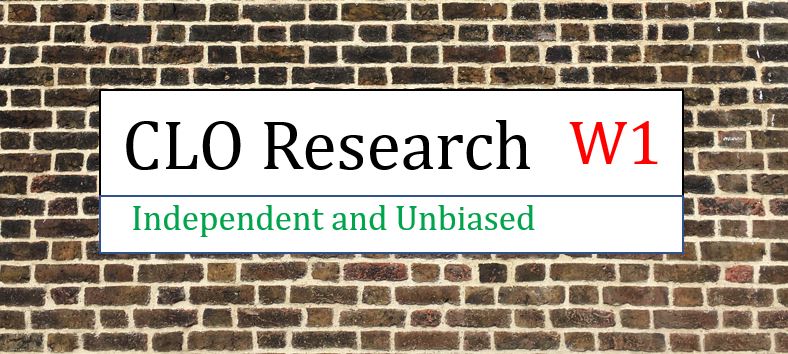“The goal is to turn data into information and information into insight.”
– Carly Fiorina, former executive, president, and chair of Hewlett-Packard Co

- Total post-2012 CLO deals updated with trustee reporting dates ranging from 15 Apr to 08 Jun – 1,407 US CLOs and 319 EU CLOs
- 412 US CLO deals or 29.3% of US CLO deals failed their Interest Diversion* or/and OC Tests.
- 9 EU CLOs or 2.8% of EU CLOs failed their Interest Diversion* or/and OC Tests.
- 89 CLO Managers (out of 164 global managers with CLO AUM of over $200 million) manage these 421 global deals.
- 280 deals (AUM of around $126 billion) failed their minimum (B or BB rating level) OC tests – $77.2 million of quarterly subordinated management fees are at risk of being deferred. The subordinated management fee is subordinated to all the rated tranches in terms of payment priority. Any deferred fees would be repaid in future if the OC tests are cured.
- 123 US CLO deals failed their BBB (rating level) OC tests. Failure of BBB OC tests would lead to the deferral of BB tranche coupons.
- 44 US CLO deals failed their A (rating level) OC tests. Failure of A OC tests would lead to the deferral of BBB tranche coupons.
- 20 US CLO deals failed their senior (AA rating level) OC tests. Failure of the senior OC test means that all mezzanine tranches would suffer from the deferral of coupons as long as the test remains breached.
 US CLOs
US CLOs
The average price of the excess CCC (S&P rating) buckets:
- $51 – deals that breached up to the minimum (B or BB) OC tests
- $50 – deals that breached up to BBB OC tests
- $51 – deals that breached up to A OC tests
- $49 – deals that breached up to AA OC tests (excluding 3 ‘non-standard’ deals)
There has been a consistent theme – assets rated by S&P suffered more downgrades to CCC than that rated by Moody’s for now. The excess CCC price was calculated based on the lowest-priced CCC assets (CCC bucket in excess of the deal’s CCC threshold – typically at 7.5% limit) constituting the excess exposure. The higher of the excess CCC or Caa bucket based on S&P or Moody’s ratings respectively would be used for the CCC or Caa haircut when calculating the OC test. In other words, the lowest-priced excess CCC/Caa assets will become mark-to-market instead of being treated at par for the calculation of the OC ratios.
The S&P/LSTA US CCC index price rallied from low-$60 in early April to mid-$70 on the 15 of Jun, but the improvement in the excess CCC price would depend on the magnitude of the lowest-priced CCC asset price rally as well as the change in the overall CCC bucket.
EU CLOs
The excess CCC price was in the mid-50s based on the average of the six deals that breached their ID tests. Only six EU CLO deals breached only the ID tests, two deals breached up to the BB/B OC tests, and one deal breached up to the BBB OC test. Given the low count of deals, the average excess CCC price trend might not be as informative as the US CLO table but could be useful for cashflow modelling in various scenarios. Like their US CLO counterparts, S&P or Fitch CCC rating bucket is consistently bigger than Moody’s Caa bucket.
*Interest diversion (ID) test only applies during the reinvestment period. If a deal breached this test, up to 50% of interest cashflows after paying the lowest-rated debt tranche would be diverted to invest in more collateral. The remaining excess interest proceeds would be used to pay the subordinated management fees before paying the equity tranche. A rough estimate would see a 60% decrease in the equity payment if the ID test remained breached.
Depending on how badly the OC tests are breached, it would take time for excess spreads to flow to the equity even when they are cured due to the payment of accrued debt coupons and deferred subordinated fees.
To find out more about the premium lite contents, please reach out via the contact page.
Disclaimers
The information, research, data, research related opinions, observations and estimates contained in this document have been compiled or arrived at by CLO Research Group, based upon sources believed to be reliable and accurate, and in good faith, but in each case without further investigation. None of CLO Research Group or its service providers; authorised personnel or their directors make any expressed or implied presentation or warranty, nor do any of such persons accept any responsibility or liability as to the accuracy, timeliness, completeness or correctness of such sources and of the information, research, data, research related opinions, observations and estimates contained in this document. All information, research, data, research related opinions, observations and estimates contained in this document are in draft form as at the date of this document and remain subject to change and amendment without notice. Neither CLO Research Group nor any of their third-party providers shall be subject to any damages or liability for any errors, omissions, incompleteness or incorrectness of this document. This article is not and should not be construed as an offer, or a solicitation of an offer, to buy or sell securities and shall not be relied upon as a promise or representation regarding the historical or current position or performance of any of the deals or issues mentioned in it.





